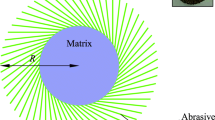Abstract
The surface roughness of nozzles has important influence on the quality of fuel atomization. The diameter of nozzles in aero engine is generally less than 1 mm. Because of the smaller diameter of the grinding wheel used, its stiffness is poor and thus the wheel tends to deflect under the grinding force. The deflection of grinding wheel has great influence on the actual feed, which ultimately affects the roughness. Therefore, a predictive model of the roughness during internal traverse grinding (ITG) is thus needed. Such a predictive model was established in this paper, in which the deflection of tool and interference of grooves were taken into consideration. In addition, the relationship between roughness and various input variables, namely, the rotating speed, the oscillation speed, the radial feed speed, the feed time, and the spark-out time, was established. Then several groups of experiments with different input variables were carried out to calibrate and validate the model, which demonstrated that the predictive model of surface roughness of ITG in small-hole nozzles has good accuracy, and provides guidance for the optimization of processing parameters.
Similar content being viewed by others
References
Hecker RL, Liang SY (2003) Predictive modeling of surface roughness in grinding. Int J Mach Tools Manuf 43:755–761
Khare SK, Agarwal S (2015) Predictive modeling of surface roughness in grinding. Procedia CIRP 31:375–380
Agarwal S, Rao PV (2010) Modeling and prediction of surface roughness in ceramic grinding. Int J Mach Tools Manuf 50:1065–1076
Sun JL, Chen P, Qin F, An T, Yu HP, He BF (2018) Modelling and experimental study of roughness in silicon wafer self-rotating grinding. Precis Eng 51:625–637
Ma LJ, Gong YD, Chen XH, Duan TY, Yang XY (2014) Surface roughness model in experiment of grinding engineering glass-ceramics. Proc Inst Mech Eng B J Eng Manuf 228:1563–1569
Wu CJ, Li BZ, Liu Y, Liang SY (2017) Surface roughness modeling for grinding of silicon carbide ceramics considering co-existence of brittleness and ductility. Int J Mech Sci 133:167–177
Zhao T, Shi YY, Lin XJ, Duan JH, Sun PC, Zhang J (2014) Surface roughness prediction and parameters optimization in grinding and polishing process for IBR of aero-engine. Int J Adv Manuf Technol 74:653–663
Chen YX, Huang Y, Xiao GJ, Chen GL, Liu ZW, Liu XM (2016) Experiment and surface roughness prediction model for Ti-6Al-4V in abrasive belt grinding. Adv Mater Res 1136:42–47
Gong YD, Wang WS, Wang B (2002) The simulation of grinding wheels and ground surface roughness based on virtual reality technology. J Mater Process Technol 129:123–126
Wang JZ, Wang LS, Li GF, Zhou GH (2005) Prediction of surface roughness in cylindrical traverse grinding based on ALS algorithm. International Conference on Machine Learning and Cybernetics 549-554
Chandrasekaran M, Devarasiddappa D (2014) Artificial neural network modeling for surface roughness prediction in cylindrical grinding of Al-SiCp metal matrix composites and ANOVA analysis. Adv Prod Eng Manag 9:59–70
Asiltürk I, Tinkir M, Monuayri HE, Celik L (2012) An intelligent system approach for surface roughness and vibrations prediction in cylindrical grinding. Int J Comput Integr Manuf 25:750–759
Daneshi A, Jandaghi N, Tawakoli T (2014) Effect of dressing on internal cylindrical grinding. Procedia CIRP 14:37–41
Cao JG, Wu YB, Li JY, Zhang QJ (2015) A grinding force model for ultrasonic assisted internal grinding (UAIG) of SiC ceramics. Int J Adv Manuf Technol 81:875–885
Yin Z, Li H, Li Y, Xie O (2011) Simulation and experiment of new whole vibrator for ultrasonic Vibration internal grinding system. Key Eng Mater 455:402–405
Nomura M, Wu YB, Kuriyagawa T, Kawashima T (2009) Study of ultrasonically assisted internal grinding of small holes: effect of grain size of cBN grinding wheel. Adv Mater Res 83-86:1002–1008
Cao JG, Wu YB, Lu D, Fujimoto M, Nomura M (2014) Fundamental machining characteristics of ultrasonic assisted internal grinding of SiC ceramics. Mater Manuf Process 29:557–563
De Payrebrune KM, Kröger M (2016) An integrated model of tool grinding: challenges, chances and limits of predicting process dynamics. Prod Eng 10:421–432
Tawakoli T, Rasifard A, Rabiey M (2007) High-efficiency internal cylindrical grinding with a new kinematic. Int J Mach Tools Manuf 47:729–733
Latifinavid M, Donder A, Konukseven EI (2018) High-performance parallel hexapod-robotic light abrasive grinding using real-time tool deflection compensation and constant resultant force control. Int J Adv Manuf Technol 96:3403–3416
Peng Y, Dai Y, Song C, Shi F (2016) Tool deflection model and profile error control in helix path contour grinding. Int J Mach Tools Manuf 111:1–8
Zhang YB, Li CH, Ji HJ, Yang XH, Yang M, Jia DZ, Zhang XP, Li RZ, Wang J (2017) Analysis of grinding mechanics and improved predictive force model based on material-removal and plastic-stacking mechanisms. Int J Mach Tools Manuf 122:81–97
Gao SW, Yang CY, Xu JH, Fu YC, Su H, Ding WF (2017) Optimization for internal traverse grinding of valves based on wheel deflection. Int J Adv Manuf Technol 96:1105–1112
Malkin S (1991) Grinding technology: theory and applications of machining with abrasives. Int J Mach Tools Manuf 31:435–436
Zhang DK, Li CH, Zhang YB, Jia DZ, Zhang XW (2015) Experimental research on the energy ratio coefficient and specific grinding energy in nanoparticle jet MQL grinding. Int J Adv Manuf Technol 78:1275–1288
Funding
This research was supported by the Fundamental Research Funds for the Central Universities of China (NO. NS2018031).
Author information
Authors and Affiliations
Corresponding author
Additional information
Publisher’s note
Springer Nature remains neutral with regard to jurisdictional claims in published maps and institutional affiliations.
Rights and permissions
About this article
Cite this article
Su, H., Yang, C., Gao, S. et al. A predictive model on surface roughness during internal traverse grinding of small holes. Int J Adv Manuf Technol 103, 2069–2077 (2019). https://doi.org/10.1007/s00170-019-03643-z
Received:
Accepted:
Published:
Issue Date:
DOI: https://doi.org/10.1007/s00170-019-03643-z



